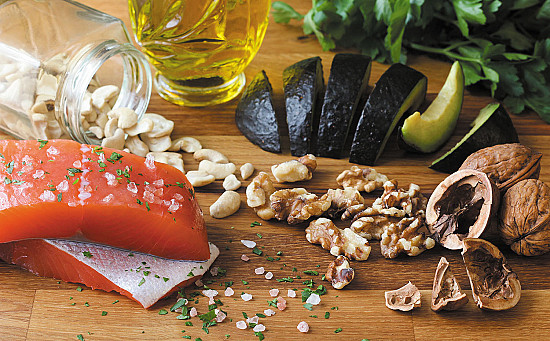Chronic joint pain is more than just a symptom; it is a complex condition often linked to inflammation, tissue degeneration, and even autoimmune reactions. Conditions like osteoarthritis—a wear-and-tear disorder affecting the cartilage—and rheumatoid arthritis, where the immune system mistakenly attacks joint tissues, contribute significantly to persistent discomfort. Organizations such as Mayo Clinic and Cleveland Clinic explain that the underlying processes, such as joint inflammation and muscle weakness, can gradually erode the body’s ability to move comfortably. Understanding these mechanisms can empower those affected to adopt changes that support long-term joint health.

The Impact of Lifestyle on Joint Pain
While medical interventions like medications and surgery have their place, lifestyle choices remain a cornerstone in managing chronic joint pain. Everyday habits—ranging from physical activity and dietary choices to stress management and sleep hygiene—directly influence inflammation and joint function. Embracing a holistic approach that combines these elements not only alleviates pain but also builds resilience against further joint deterioration. Evidence from experts at UT Health and Orthopedic Wellness underscores the value of integrating lifestyle modifications with traditional treatment methods.
Stay Active with Regular Exercise
Physical activity is one of the most effective non-pharmacological strategies for managing joint pain. Regular exercise offers several benefits:
- Improved Joint Mobility: Engaging in low-impact activities such as walking, cycling, swimming, or water aerobics helps maintain the range of motion in the joints while strengthening the surrounding muscles. This, in turn, supports the joints and minimizes discomfort.
- Enhanced Muscle Strength: Strengthening exercises build the muscle mass that supports the joints, reducing the load on the joint surfaces and decreasing pain. Techniques like resistance training or using body-weight exercises can be tailored to individual capabilities.
- Reduced Inflammation: Consistent physical activity helps lower systemic inflammation—a major contributor to joint pain—by promoting healthy blood circulation and releasing natural pain-relieving endorphins.
- Better Mood and Energy: Exercise is well known to improve mental health, alleviating symptoms of depression and anxiety that often accompany chronic pain.
For those new to exercise, working with a physical or occupational therapist can help create a personalized routine. Programs developed by professionals, as highlighted by Monadnock Community Hospital, can start with gentle stretches and gradually build to more structured workouts, ensuring that the activities complement the individual’s pain thresholds and overall fitness levels.
Maintaining a Healthy Weight
Excess body weight puts additional stress on weight-bearing joints, such as the knees, hips, and lower back, exacerbating pain and accelerating joint deterioration. Research indicates that even a modest reduction in weight can alleviate pressure on these joints, potentially slowing the progression of conditions like osteoarthritis. Here are some strategies to achieve and maintain a healthy weight:
- Balanced Diet and Portion Control: Adopting a diet rich in whole foods—fruits, vegetables, lean proteins, and whole grains—helps manage weight while providing essential nutrients for joint health.
- Regular Monitoring: Keeping track of weight loss progress and adjusting dietary habits accordingly can create a sustainable plan that encourages gradual, steady results.
- Integrative Approach: Combining weight management with regular exercise amplifies the benefits, as physical activity not only burns calories but also strengthens the muscles around the joints, further easing the strain.
Studies from the Arthritis Society Canada and NYU Langone emphasize that weight loss is not just about aesthetics—it’s a powerful tool in reducing joint pain and improving overall joint function.
Embracing a Balanced, Anti-Inflammatory Diet
What you eat plays a crucial role in managing chronic joint pain. An anti-inflammatory diet focuses on reducing systemic inflammation, a key factor that contributes to joint discomfort. Here are some dietary recommendations to consider:
- Increase Intake of Fruits and Vegetables: These foods are rich in antioxidants and polyphenols, which help neutralize free radicals and reduce inflammation. Berries, leafy greens, and cruciferous vegetables are excellent choices.
- Healthy Fats: Omega-3 fatty acids, found in fatty fish (like salmon and mackerel), flaxseeds, chia seeds, and walnuts, are known for their anti-inflammatory properties. Replacing saturated fats with these healthier fats can have a significant impact on reducing joint pain.
- Whole Grains: Choosing whole grains over refined carbohydrates helps regulate blood sugar levels and supports overall metabolic health.
- Lean Proteins: Incorporating lean protein sources, such as chicken, fish, beans, and legumes, supports muscle repair and growth without adding excess fat.
- Avoid Processed Foods: Highly processed foods, sugary snacks, and refined carbohydrates can promote inflammation and should be limited.
Research shared by Harvard Health supports the idea that dietary modifications can directly influence inflammation and, consequently, pain levels. By making deliberate food choices, individuals can create a dietary pattern that not only nourishes the body but also helps in managing chronic pain.
Managing Stress and Enhancing Mental Well-Being
Chronic pain often goes hand in hand with emotional stress, anxiety, and depression. The interplay between mental health and physical pain is complex—stress can exacerbate pain, and persistent pain can lead to mental health challenges. Adopting effective stress management techniques can, therefore, have a direct impact on reducing joint pain.
- Mindfulness and Meditation: Practices such as mindfulness meditation encourage a focus on the present moment, reducing anxiety and altering the perception of pain. This can lead to improved pain coping mechanisms.
- Cognitive Behavioral Therapy (CBT): CBT is a form of talk therapy that helps reframe negative thoughts and behaviors related to pain. Studies indicate that CBT and pain coping skills training can improve both psychological and physical outcomes in chronic pain patients.
- Relaxation Techniques: Deep breathing exercises, progressive muscle relaxation, and even engaging in hobbies that bring joy can reduce stress levels and improve overall well-being.
- Social Support: Building and maintaining strong social connections provides emotional support, which is vital in managing chronic pain. Even if physical limitations make it difficult to be as active socially, virtual support groups and communities can offer a sense of belonging and understanding.
The importance of mental health in pain management is underscored by findings from sources like Hopkins Medicine, which note that reducing stress and engaging in therapy can significantly improve pain outcomes.
Prioritizing Quality Sleep
Sleep is a critical component of the body’s healing process. Poor sleep can not only worsen pain perception but also contribute to systemic inflammation. Here are some tips to improve sleep quality:
- Establish a Consistent Routine: Going to bed and waking up at the same time every day helps regulate the body’s internal clock.
- Create a Restful Environment: A quiet, cool, and dark room is ideal for sleep. Limiting exposure to screens and electronics at least an hour before bedtime can also help.
- Relaxation Before Bed: Engage in calming activities such as reading, gentle stretching, or listening to soft music to signal to the body that it’s time to wind down.
- Avoid Caffeine and Heavy Meals: Particularly in the evening, these can disrupt sleep patterns and make it harder to fall asleep.
Good sleep hygiene not only improves the quality of rest but also enhances the body’s natural healing processes, ultimately reducing chronic joint pain.
Quitting Smoking and Moderating Alcohol Intake
Smoking has a detrimental effect on joint health. It compromises the integrity of connective tissue and impairs blood flow, thereby reducing the body’s ability to heal and manage inflammation. Quitting smoking can lead to significant improvements in overall health and reduce the severity of joint pain.
Similarly, while moderate alcohol consumption might not directly worsen joint pain for everyone, excessive drinking can interfere with medications and contribute to systemic inflammation. Reducing alcohol intake can, therefore, be beneficial for those struggling with chronic joint issues. Resources from NYU Langone and Aurora Health Care stress the importance of lifestyle choices like these in managing symptoms and preventing further joint damage.
Integrating a Holistic Approach
While each lifestyle change independently offers benefits, the greatest improvements in managing chronic joint pain often come from combining these strategies. A holistic approach acknowledges that physical, emotional, and mental health are deeply interconnected. For example, regular exercise not only strengthens muscles and supports joints but also improves mood and sleep quality. Similarly, a balanced diet reduces inflammation and supports weight management, while effective stress management techniques enhance the ability to stick with an active lifestyle.
Creating a personalized plan that incorporates multiple elements of lifestyle change requires time and patience. Consulting with healthcare professionals—such as physical therapists, dietitians, or mental health counselors—can provide tailored advice that aligns with individual needs and goals. As NCBI notes, integrating these changes into daily life is a dynamic process that benefits from regular adjustments and support.
Practical Tips for a Sustainable Change
Adopting a healthier lifestyle to manage chronic joint pain doesn’t happen overnight. Here are some practical strategies to help build long-term habits:
- Start Small: Introduce gradual changes rather than attempting a complete overhaul of daily routines. For instance, begin by incorporating a 10- to 15-minute walk each day and slowly increase the duration as stamina improves.
- Set Realistic Goals: Establish clear, attainable objectives for weight loss, physical activity, and dietary changes. Track progress regularly to celebrate small victories along the way.
- Build a Support Network: Connect with others who are on a similar journey, whether through local support groups, online communities, or social networks. Sharing experiences and tips can provide both motivation and accountability.
- Plan and Prepare: Spend a little extra time planning meals, scheduling exercise sessions, and setting aside moments for relaxation. Preparation reduces stress and increases the likelihood of sticking to the new routine.
- Monitor Progress: Keeping a journal of activities, food intake, mood, and pain levels can reveal patterns that help in fine-tuning the approach. Over time, these insights can be shared with healthcare professionals to adjust the plan as needed.
The Science Behind the Changes
Many studies have demonstrated the effectiveness of lifestyle interventions in managing chronic joint pain. For instance, research published by Harvard Health shows that an anti-inflammatory diet can reduce systemic inflammation and help alleviate pain. Similarly, findings from NYU Langone emphasize that exercise and weight management are critical factors in reducing joint stress and improving mobility. In addition, psychological approaches such as cognitive behavioral therapy have been proven to improve pain coping skills, leading to better long-term outcomes for those suffering from chronic pain.
Understanding these scientific principles helps demystify the process. Inflammation, for example, is the body’s natural response to injury or infection. However, when this response becomes chronic, it contributes to ongoing pain and tissue damage. By targeting the underlying inflammation through diet, exercise, and stress reduction, individuals can interrupt this cycle and promote healing.
Combining Traditional and Alternative Approaches
Many healthcare experts advocate for a multidisciplinary strategy to combat chronic joint pain. While medications and surgical interventions may be necessary in some cases, lifestyle modifications provide a complementary pathway that addresses both the symptoms and the root causes of pain. Incorporating elements like physical therapy, nutritional counseling, and psychological support creates a balanced approach that targets the whole person, not just the symptoms.
For example, a patient might benefit from traditional treatments such as non-steroidal anti-inflammatory drugs (NSAIDs) while also participating in a structured exercise program and adopting a Mediterranean-style diet. These combined efforts not only help control pain but also reduce the risk of developing additional health issues over time.
Key Takeaways
- Exercise Regularly: Engaging in low-impact activities can significantly improve joint flexibility, muscle strength, and overall function.
- Manage Your Weight: Reducing excess body weight takes the pressure off your joints and may slow the progression of joint damage.
- Eat an Anti-Inflammatory Diet: Foods rich in antioxidants, omega-3 fatty acids, and whole grains support joint health and reduce inflammation.
- Reduce Stress: Incorporating mindfulness, meditation, and cognitive behavioral techniques can alter the perception of pain and enhance mental resilience.
- Prioritize Sleep: Quality sleep is essential for recovery, helping to lower inflammation and restore energy levels.
- Avoid Harmful Habits: Quitting smoking and moderating alcohol intake contribute to better joint health and overall wellness.
- Seek Professional Guidance: Tailoring a lifestyle plan to personal needs is most effective when done in consultation with healthcare providers.
Moving Forward
Managing chronic joint pain is a journey that requires persistence and adaptability. Each small change—whether it’s a short walk after dinner, swapping out a processed snack for a piece of fruit, or taking a few minutes to practice deep breathing—adds up over time to create a healthier, more resilient body. With the right mindset and support, it is possible to regain control over your pain and live a more active, fulfilling life.
Making these lifestyle adjustments is not an overnight fix, but a continuous, rewarding process. Each day brings new opportunities to refine habits, overcome challenges, and build a healthier future. Start today, take that first step, and let the journey toward managing chronic joint pain empower you to live your life more fully.
A comprehensive strategy that combines physical activity, balanced nutrition, stress management, and healthy sleep patterns lays the foundation for long-term success. Remember, these lifestyle changes are not meant to replace traditional medical treatments but to work alongside them, offering a well-rounded approach to managing pain.
Sources:






For those looking to dive deeper into the science and practical tips behind these changes, exploring resources from UT Health or Hopkins Medicine.







